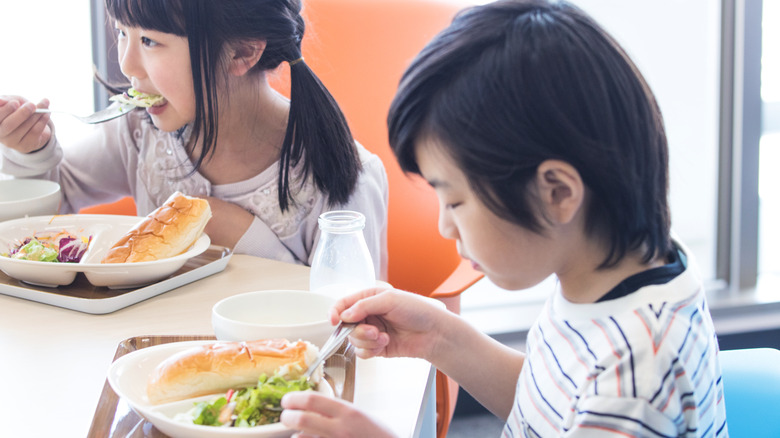What Lunch Looks Like For Japanese Students
Across the globe, many students are eating school lunches that are free or subsidized in some manner: Over 161 countries have national food programs that make the daily midday meal an important part of the educational system. Each one, however, obviously serves up its own fare, meaning school lunches around the world are a unique reflection of a particular nation's culture, economy, and value system.
Japan's school lunch program, kyūshoku, is so integrated into the education of children that lunches are served inside the classroom in all public elementary and junior high schools throughout the country. Lunch at school is not just a lesson in food but also a tool to teach students dining etiquette, a sense of community with local farmers and produce, service, ownership over meals, and nutrition.
In Japan, you won't find any rotting or undercooked school lunches (as has unfortunately been reported in some American public schools). Here's an inside look at what Japanese students eat for their midday repast.
Lunch is made with particular standards
At the Musashino City School Lunch & Dietary Education Promotion Foundation, meals are planned by a certified nutritionist and then freshly prepared by a staff of 181 people to be served the same day. One Youtuber, Paolo from Tokyo, was given special access inside the facility where the days begin at 7:30 a.m. with ingredient deliveries that are rigorously inspected and temperature-checked in accordance with government guidelines.
Produce from local farmers like burdock and lotus root are washed, cut, and peeled. There is an emphasis on eating seasonal ingredients, which falls in line with shokuiku – a philosophy imparted in the education system that teaches kids to eat healthy by listening to one's body, following a varied diet consisting of mainly whole foods, and sharing meals amongst family and friends.
Rice is made in a giant vat. Fish is marinated, then grilled. There are even taste-testers to ensure the quality of the food, which is then packaged into thick metal containers so the lunch is still hot when delivered to the schools by 11:30 a.m.
The diversity, affordability, and interactivity of Japanese lunch
Japanese lunches have a fairly consistent formula of soup, rice, salad, a portion of meat or fish, and a bottle of milk, which is based on the traditional washoku meal structure. But a standard formula doesn't preclude variety: The ingredients that make up this meal are always made with in-season ingredients so that the menu changes frequently. On the sweet side, dessert is more the rare exception than the rule: A fruit or sweet bread is typically served a few times a month. Hot tea, however, is often served with school lunch in Japan.
Lunches are highly subsidized by the Japanese government and cost approximately $2.50 per day, but their most unique aspect is how the food is served. The students themselves are in charge of collecting meals from the prep room, serving them to their classmates, and then ferrying the dirty dishes away. Other students are tasked with putting down placemats and small towels or napkins, as well as pushing desks together to accommodate a communal eating experience (teachers eat alongside their students). Finally, students put on protective smocks and wash their hands before eating.
Low obesity rates with uniform lunches
With such an involved national school lunch program, Japanese child obesity rates are amongst the lowest in the world and have continued to go down as the program has expanded. However, there is no room for pickiness, as students all receive the same meal and are expected to finish it in its entirety — down to even the last few grains of rice.
But picky eaters wouldn't even be able to sate their hunger elsewhere, since students generally aren't allowed to bring outside food into schools until they reach high school. And with no vending machines in sight, there are no snacks in school either.
Having such a highly regimented lunch where all students are required to eat what is provided makes it more difficult for those with allergies or dietary restrictions; they are typically served the same meal — just with the undesired ingredient (or the menu item that contains the undesired ingredient) removed. But in special circumstances, they might be allowed to bring their own packed lunch.
At the end of the day, Japanese students go home with full bellies and a full education on which food is in season, how to serve it, and how to clean up after themselves.



